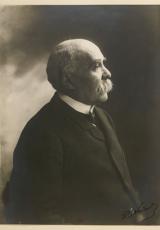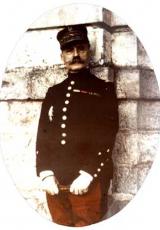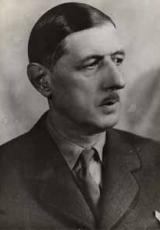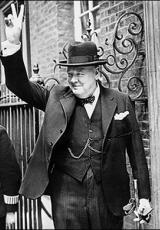11 November: a day of remembrance
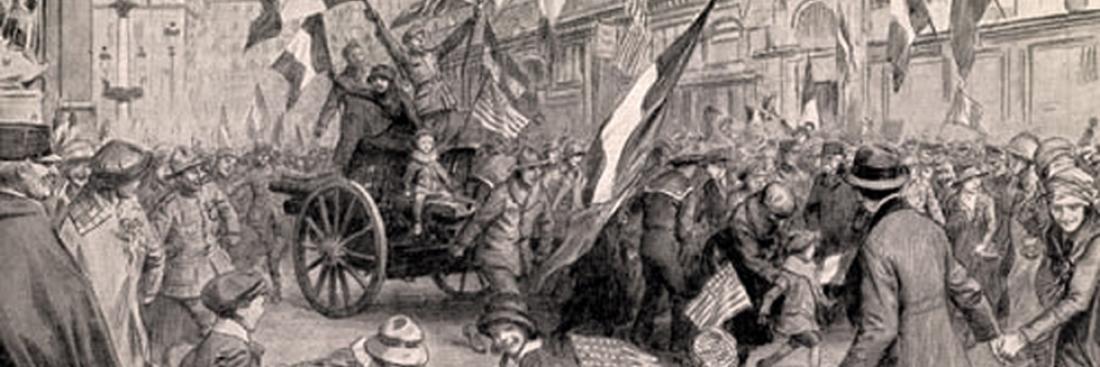
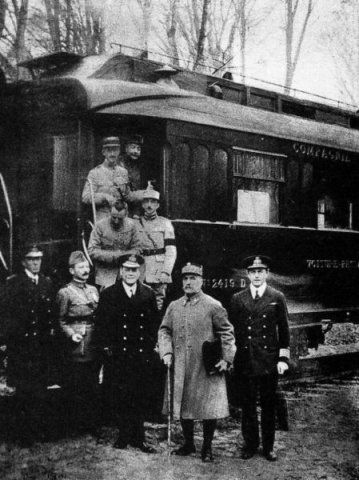
The Armistice procession, 11 November 1918. Source: SHD collection
At the Palais Bourbon, at 4 pm, Clemenceau read the conditions of the Armistice, saluted Alsace and Lorraine and paid homage to the nation.
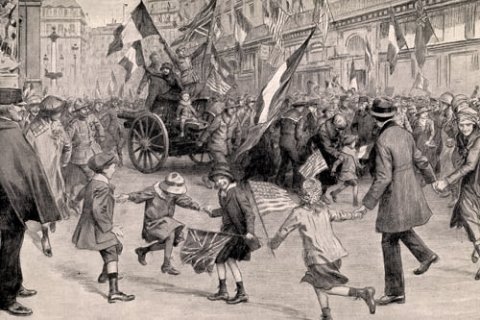
German cannons being dragged, 11 November 1918, Place de l'Opéra and the boulevards, amidst the farandoles.
Source: Album of the war of 1914-1919. © L'illustration
This ”day of joy” could never, however, allow this veteran of war, on his return to civilian life, to forget the tragic experience nor the message he carried. He wanted to let the nation know that the courage and sacrifices of the soldiers during the four years of war would remain in everybody's memory.
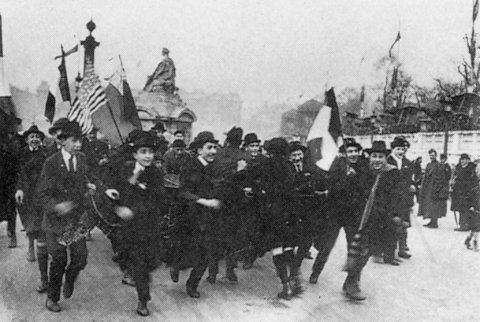
11 November 1918. Source: Paris - Roger-Viollet
It was the veterans who gradually imposed their wish for 11 November to be made a national holiday.
11 November 1919: a discreet day of homage
On 11 November 1919, a single ceremony was organised in the Invalides Chapel in the presence of Marshal Foch.
This same year, two commemorative days had already made an impression on the public:
-
14 July 1919, the nation celebrated the victory and peace in at ambience of splendour and jubilation. Homage was paid to all the soldiers, those living and dead. Clemenceau wanted this to be ”their” day. In Paris, a thousand war casualties headed the victory parade of the Allied armies that passed under the Arc de Triomphe, watched by endless crowds of spectators. A cenotaph built under the Arc received, the night of the 13th, an homage from the people to those who died for the nation.
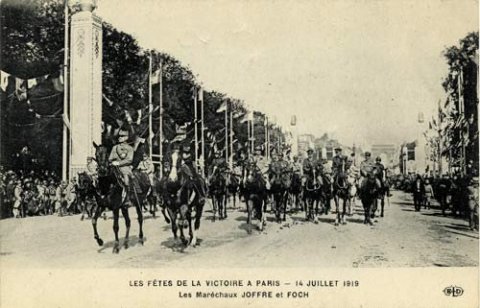
The victory celebrations in Paris - 14th July 1919 - Marshals Joffre and Foch. Source: post card
- On 2 November 1919, the first ”day of the dead” since the return to peace, numerous symbolic ceremonies were held in honour. The Parliament wished for the dead to be glorified in every town and village in France, on the same day at the same time. Less a day of official ceremonies, this 2 November was rather a day dedicated to individual tributes paid by mothers, widows and orphans in the cemeteries and military cemeteries of the Front.
11.11.20: the first homage to the Unknown Soldier
The year 1920 was an important date for the Third Republic, which celebrated its 50th anniversary.
On 11 November of this year, the Republic paid homage to the first time to an unidentified soldier killed during the Great War, representing the anonymity of the heroic mass of infantrymen, a symbol of these brothers of war.
First proposed in 1916, the idea to honour an unknown soldier was adopted in 1918. On 12 November 1919, the Pantheon was chosen as the place of burial. But in 1920, a campaign led by writers saw the Arc de Triomphe be chosen as the final resting place.
The following law was passed unanimously by Parliament:
”Article 1: The honours of the Pantheon will be attributed to the remains of one of the unidentified soldiers who died on the field of honour during the war of 1914-1918.
Article 2: The same day, the remains of the unknown soldier will be buried beneath the Arc de Triomphe”.
The deputies adopted the law on 8 November; the Senate on 9 November.
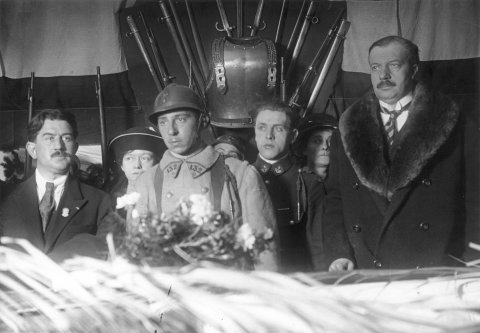
10 November 1920, Verdun. Source: Roger-Viollet
On 10 November, the soldier Auguste Thin selected the unknown soldier in Verdun. The coffin arrived in Paris and joined, for the 11 November ceremony, the reliquary holding the heart of Gambetta which was to be transferred to the crypt in the Pantheon.
A huge crowd accompanied the procession from the Pantheon to the Arc de Triomphe. Temporarily, the coffin was sheltered in a burning chapel on the first floor of the monument open to visitors.
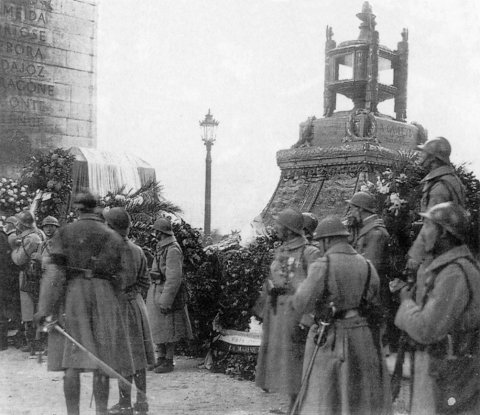
11 November 1920, Paris Source: Roger-Viollet
1921 : Burial of the Unknown Soldier
On 28 January 1921, the Unknown Soldier was buried beneath the Arc de Triomphe vault.
The following words are engraved on the granite slab: ”Ici repose un soldat français mort pour la Patrie (1914-1918)” (Here lies a French soldier who died for the fatherland (1914-1918)).
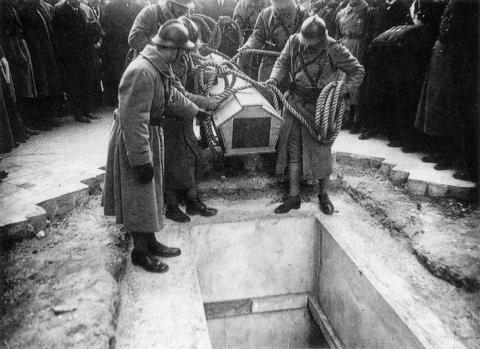
28 January 1921, Paris. Source: Roger-Viollet
1922 : 11 November, a national day of remembrance
Throughout 1922, the war veterans campaigned for Parliament to declare 11 November a national holiday, which was finally set forth by the law of 24 October 1922.
1923 : the flame of remembrance
On 11 November 1923, in the presence of numerous veterans' associations, André Maginot, minister of war and pensions, was the first to light the flame of remembrance. The torch for the flame was created by the wrought iron craftsman Brandt.
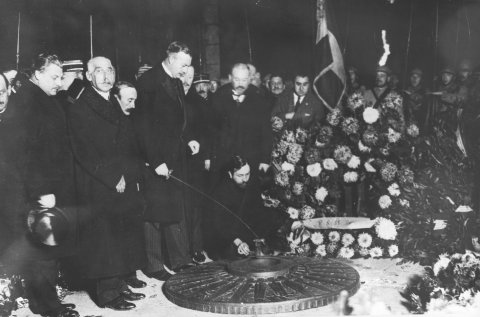
11 November 1923, Paris. Source: Roger-Viollet
The Flame Committee would now have the task of rekindling the flame every day at dusk.
Over the years, the flame has been relit by associations of war veterans and the Gold Book of the Arc de Triomphe has been signed by numerous guests of France. In just four years, an annual ceremony was born and fast became a tradition.
At the same time, a monument to the dead was erected in every town in France, which became the centre point of the ceremony organised by each municipality on 11 November: a procession led by the authorities, patriotic associations, school children and members of the community.
11 November at the service of the Resistance (1940-45)
11 November 1940: challenging the occupier
As 11 November 1940 approached, the German authorities and the police headquarters made the decision to ban all forms of commemorative demonstration.
The commissioner of education for Paris thought it wise to send a memo to all the head teachers to forewarn them to stop their students from demonstrating. Since the start of the school year, tracts calling for people to join the struggle and anti-German inscriptions written on walls appeared in Parisian schools and universities. The arrest of Paul Langevin, a teacher at the Collège de France and internationally-renowned doctor, incited an immediate reaction.
On 8 November, a first demonstration was organised and while it failed to reach the scale expected, the idea of an even bigger demonstration soon took hold. Tracts and watchwords from various sources called for people to unite at the Arc de Triomphe on 11 November.
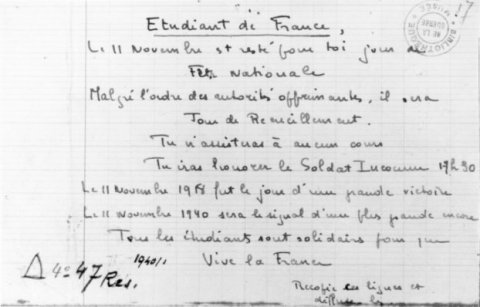
Tract calling people to demonstrate on 11 November 1940. Source: BDIC
That day, several processions of between 3,000 and 5,000 university and school students converged on the Champs-Élysées. The hostility directed at the occupier was widespread and references to General de Gaulle hung in the air.
The repressive measures used were brutal; many were injured and a hundred or so students were arrested and imprisoned.
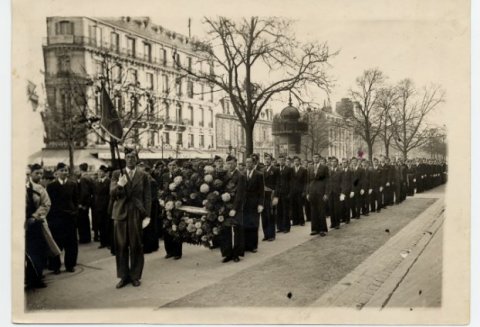
Demonstration of 11 November 1940. Students from the Institut agronomique prepare to march long the Champs Élysées
to lay flowers on the Tomb of the Unknown Soldier. Source: Museum of National Resistance - Champigny-sur-Marne
For the first time since June 1940, French citizens clashed with the occupying forces. This 11 November became a true symbol for the Paris resistance, for all French citizens, in the occupied as well as the liberated zones, but also for the free French who, from London to Brazzaville, learned of this major act of resistance whose importance was so emphatically conveyed across the airwaves from London.
11 November 1944: a Franco-British ceremony in liberated Paris
In 1944, most of the French territory was liberated. The 11th of November was commemorated in Paris in the presence of a British delegation, led by the British Prime Minister Winston Churchill, and General de Gaulle, head of the provisional French government.
The Provisional Government presented this invitation as the sacralisation of the great war alliance. This was the occasion for both governments to come together and discuss the common effort against the forces of the Axis of Evil.
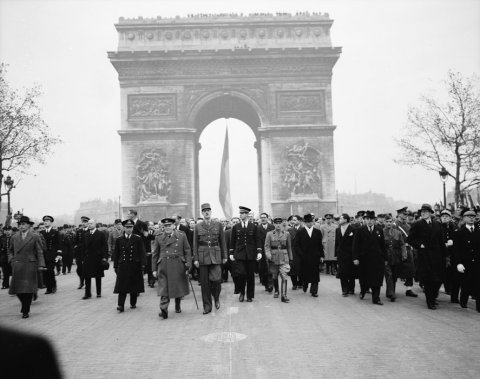
Parade on 11 November 1944 along the Champs-Elysées. General de Gaulle, head of the Provisional Government
of the French Republic, and Winston Churchill, British Prime Minister, followed by the procession of officials. © Ecpad
As General de Gaulle reminded the people:
”We are pleased to see in the presence of our guests, not just the long-awaited opportunity to salute them in our capital city, but also a practical demonstration of an alliance that cruel vicissitudes make seem more necessary than ever”.
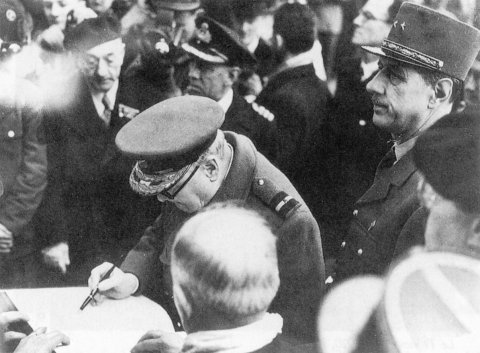
11 November 1944, Churchill and de Gaulle. Source: Roger-Viollet
11 November 1945: an homage to all fighters
The following year, the ceremonies on 11 November 1945 reflected General de Gaulle's intention to make Mont Valérien, a theatre of martyrdom, a major site of remembrance for the soldiers and the victims of Nazism.
On 10 November, the bodies of 15 French casualties of war who died for their fatherland were carried in three processions from the gates of Paris to the Invalides, soldiers from the three branches of the armed forces, prisoners, deportees, men and women, symbolising both national unity and the many different theatres of operations and places of suffering.
On 11 November, a single procession accompanied these 15 coffins beneath the Arc de Triomphe where they were welcomed by General de Gaulle. During the day, the crowds paid tribute. Then, at nightfall, they were laid at Mont Valérien.
11 November at the service of remembrance (1945 to today)
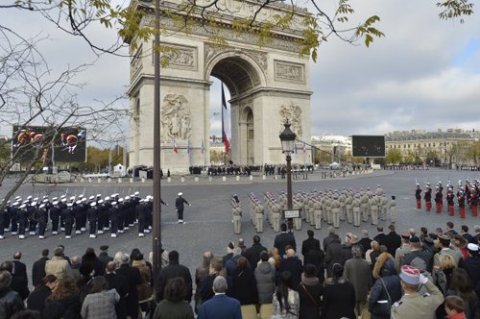
11 November 2012. Source: Photo Jacques Robert
The 11th of November, the day of commemoration of the Armistice of 1918, gradually became an occasion to question and try to make sense of history.
From that year on, this day of remembrance was a regular opportunity to call to mind a particular episode of the Great War, sometimes associated with a broader subject depending on the anniversaries that fell that particular year: in 1989, the Great War and the memory of the French Revolution; in 1992, the colonial troops in the First World War; in 1998, the Allied contribution to the First World War; in 2003, the 85th anniversary of the Armistice of 1918 and the 80th anniversary since the Flame of Remembrance was first lit by André Maginot; in 2004, the outbreak of war and victory in the Marne; in 2006, Verdun; in 2008, the 90th anniversary of the Armistice of 1918.
This ceremony has retained its meaning today as a day to pay homage to the soldiers so the sacrifices and suffering experienced by a whole generation are never forgotten. An important part of the commemoration is to ensure the younger generations inherit the values so fiercely defended by our ancestors.
On 28 February 2012, the French Parliament established 11 November as a day of homage to all those who died for France (law no. 2012-273). Without abandoning the historic legacy of the First World War and the other national commemorative days, this law conferred an even greater sense of solemnity on the celebration of 11 November.
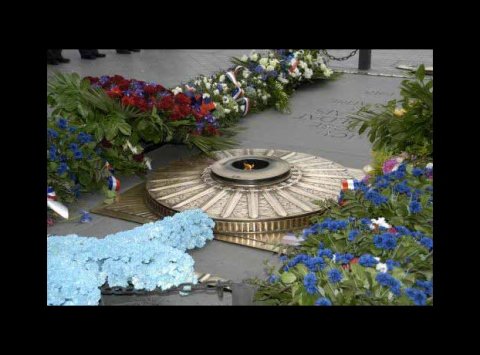
The flame beneath the Arc de Triomphe. Source: Photo Jacques Robert


